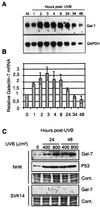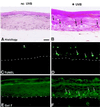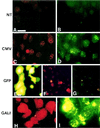Galectin-7 overexpression is associated with the apoptotic process in UVB-induced sunburn keratinocytes
- PMID: 10500176
- PMCID: PMC18033
- DOI: 10.1073/pnas.96.20.11329
Galectin-7 overexpression is associated with the apoptotic process in UVB-induced sunburn keratinocytes
Abstract
Galectin-7 is a beta-galactoside binding protein specifically expressed in stratified epithelia and notably in epidermis, but barely detectable in epidermal tumors and absent from squamous carcinoma cell lines. Galectin-7 gene is an early transcriptional target of the tumor suppressor protein P53 [Polyak, K., Xia, Y., Zweier, J., Kinzler, K. & Vogelstein, B. (1997) Nature (London) 389, 300-305]. Because p53 transcriptional activity is increased by genotoxic stresses we have examined the possible effects of ultraviolet radiations (UVB) on galectin-7 expression in epidermal keratinocytes. The amounts of galectin-7 mRNA and protein are increased rapidly after UVB irradiation of epidermal keratinocytes. The increase of galectin-7 is parallel to P53 stabilization. UVB irradiation of skin reconstructed in vitro and of human skin ex vivo demonstrates that galectin-7 overexpression is associated with sunburn/apoptotic keratinocytes. Transfection of a galectin-7 expression vector results in a significant increase in terminal deoxynucleotidyltransferase-mediated UTP end labeling-positive keratinocytes. The present findings demonstrate a keratinocyte-specific protein involved in the UV-induced apoptosis, an essential process in the maintenance of epidermal homeostasis.
Figures





References
-
- Fuchs E. Curr Opin Cell Biol. 1990;2:1028–1035. - PubMed
-
- Sun T, Eichner R, Schermer A, Cooper D, Nelson W, Weiss R. In: Cancer Cells 1: The Transformed Phenotype. Levine A J, Van de Woude G F, Topp W, Watson J D, editors. Plainview, NY: Cold Spring Harbor Lab. Press; 1984. pp. 169–176.
-
- Fuchs E, Dowling J, Segre J, Lo S, Yu Q. Curr Opin Genet Dev. 1997;7:672–682. - PubMed
-
- Steinert P, Marekov L. J Biol Chem. 1995;270:17702–17711. - PubMed
-
- Barrandon Y. Semin Dev Biol. 1993;4:209–215.
Publication types
MeSH terms
Substances
LinkOut - more resources
Full Text Sources
Other Literature Sources
Medical
Research Materials
Miscellaneous

